Make no mistake: The digital age is here to stay. We play with two cutting edge computer programs and lay out what you need to know about modeling. If
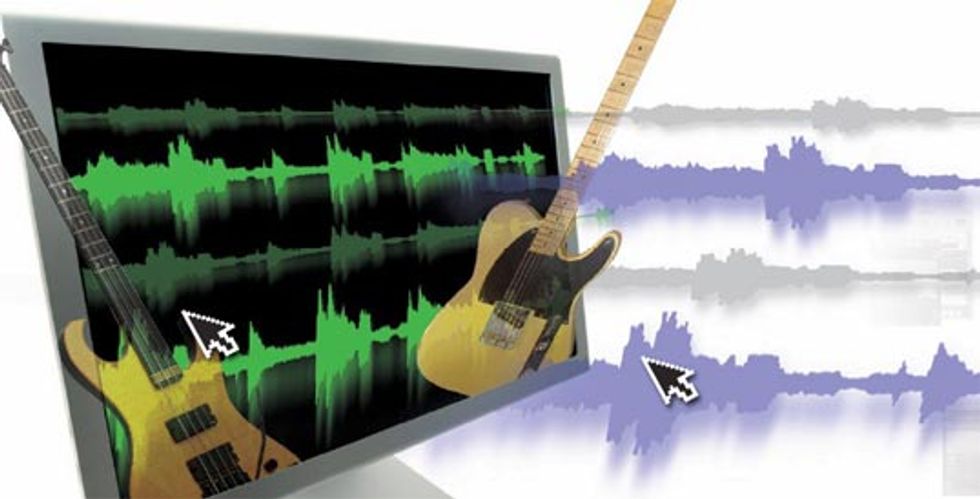
|
What is it?
Software that digitally “models” the sound of classic guitar amps and effects through the use of advanced algorithms is all the rage these days. By painstakingly measuring the behavior of every part of the signal chain – from vacuum tubes, preamps, amps, speakers, microphones and effects – engineers have developed some very convincing software technology for the modern guitarist. While it would certainly be fun and inspiring to have several different classic tube amps and a pedalboard full of the greatest effects of all time at every gig, who can really pull that off? Most of the gear modeled in this software is now prohibitively expensive to own and requires constant upkeep, too. When you consider the sheer manpower needed to move it around, it quickly becomes impractical on several levels. With modeling software, you have a believable emulation of the real thing.
If we buy into the premise that most of us already have a computer, then it is reasonable to assume that we should find ways to use that computing horsepower to do something of creative value. AmpliTube 2, from IK Multimedia (fig 1) and Guitar Rig 2, from Native Instruments (fig 2), are two well-designed and highly-evolved applications in the world of guitar amp and effect modeling. Both existed in previous incarnations and were hailed as breakthrough products at the time, but Guitar Rig 2 and AmpliTude 2 pack in more new features and even better sound quality. It seems that things just keep getting better for digitallyinclined axe slingers.
What can they do?
There are some similarities between these two applications, so let’s take a look there first. Both apps feature a “virtual” rack where you can select amps, speaker cabs, microphones and sound effects to create your own “preset” sound. Most of the classic combinations are available – from plexi Marshalls, the ’59 Fender Bassman, and the Vox AC30 to modern classics like Mesa Boogie – albeit, sometimes with thinly veiled names, such as Brit Tube 30TB or AC Box, Plex, Tweedman, etc.
From muscular blues and boogie to metal and high gain grind to ambient and spacious, both products feature a vast world of tonal possibilities. Tone tweakers and gear freaks will feel right at home in the computer modeling world, with options to select what type of virtual speaker cabinet is connected (closed back Celestion, open back Fender, etc.) and even which type of virtual mic you want in front of your cab, ranging from the old standby Shure SM57 to high-end tube condensers; you can even choose to aim the microphone directly at the virtual speaker or off-axis, satisfying the most compulsive tone hounds. Each of these choices makes for a fairly dramatic change in tone and the flexibility allows you to dial in the exact sound you’re looking for.
As intimidating as the world of computerized guitar can be to the uninitiated, the best course of action with both of these applications is to simply dive right in. Why not try a Marshall type of amp with an 8” open back cabinet? Wouldn’t it be cool to try a Fender Twin Reverb through a 4x12 closed back cabinet? Experimentation is fun and yields lots of great sounding combinations. When you add all of the virtual stomp box and rack effects, such as wah, chorus, flanger, delay, distortion and reverb – plus a few wild and crazy effects in each program – you have serious tone-shaping power.
If you just want to plug and play, both applications serve up an extensive list of preset tones in a broad range of older and modern styles that make it a cinch to get started. One could easily spend a week just auditioning the presets. Each new preset inspired me in a different direction; from pumping out solid rhythm guitar to Chicago blues to modern high-gain leads. It was very entertaining to spend some time with each preset and I would highly recommend it if you want to get a firm handle on all of the sound possibilities available. Banks and presets in various styles make it simple to see what each application can do. Even to an experienced set of ears, most of these sounds are extremely convincing. The models are expansive, dynamically responsive like a tube amp should be (more on that a bit later) and just plain fun to use on stage or in the studio. Guitar Rig 2 includes a “Rig Kontrol” footpedal that makes using it in a live setting easy. Not to be outdone, IK Multimedia has a foot controller for AmpliTube 2 coming soon called Stomp I/O. When using these applications in a studio setting, they can also function as plug-ins within recording applications such as Pro Tools, Digital Performer and Logic. Consider how convenient it is to dial in any sound you can imagine, at any volume and hour of the day or night – and even having the flexibility to change sounds after the fact. This is sheer sonic bliss and would have seemed like some kind of virtual voodoo just a few short years ago!
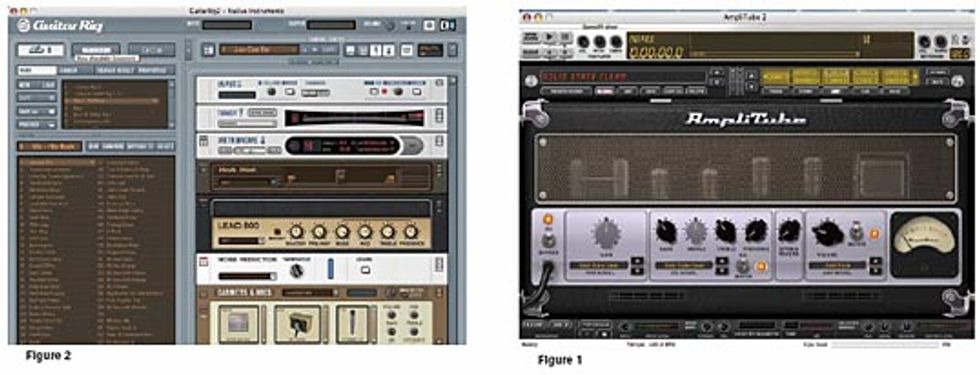
How does it work?
Those of you new to computer audio may need a little explanation at this point, in order to get your guitar signal into the computer and application. Generally speaking, you’ll need an audio interface that has a high-gain instrument input on it. These come in several varieties, usually USB, FireWire or USB 2.0. Each company approaches this differently – the Guitar Rig 2 Rig Kontrol footpedal also happens to be a USB 2.0 audio interface and is quite convenient. After installing the software, simply plug the footpedal into your computer via a USB 2.0 port (make sure you have this type of port before buying), plug your guitar into the foot controller and commence rocking.
With AmpliTube 2, you can use any audio interface you like, and there are quite a few interface options under $100, such as the M-Audio Fast Track or JamLab, or IK’s own Stealth Plug. In this scenario, you’ll need to make sure your computer “sees” your interface for audio input and that the application itself also sees it for audio input. This should all be handled during the interface’s installation phase.
After getting your interface set up, if you are using either application in stand-alone mode, you will be ready to plug and play. If you are using either application as a plug-in with Pro Tools or another recording program, you will need to create a track in that application for your guitar and then “insert” the modeling software on that track. You’ll want to reference the recording application’s manual if you’re unsure of how this works. It can be a little confusing to get it all configured correctly, but it is definitely worth the patience required. Once you get it working, the settings are retained for future use.
It’s important to note that, depending on where you live, you may or may not be able to try either of these applications out before you buy them, because stores rarely have them installed on a computer and accessible for demos. Most stores will not return opened software, make sure your computer can handle the processing needs of the program/interface – you can find this on the side of the box, under “Minimum Requirements.”
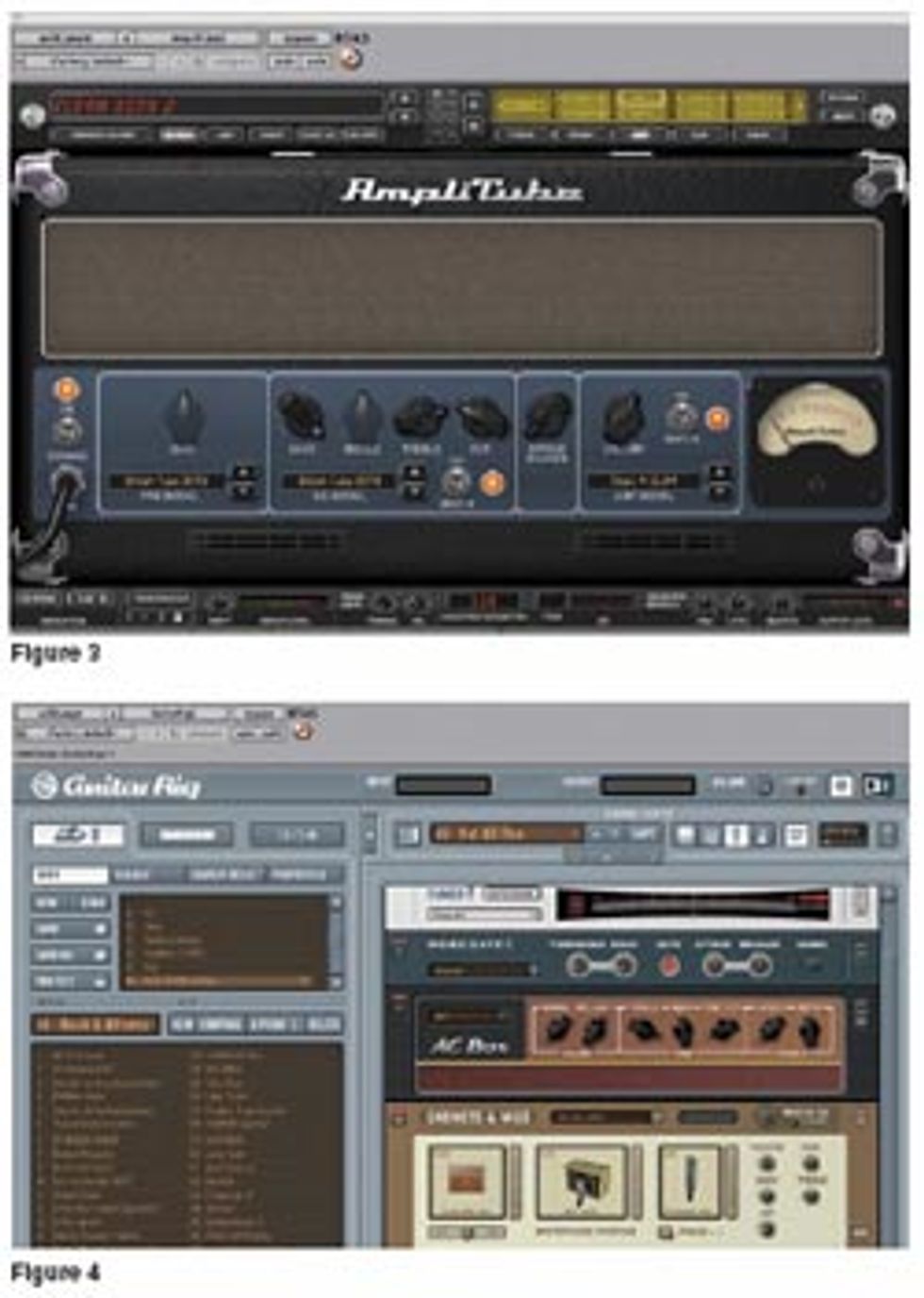 |
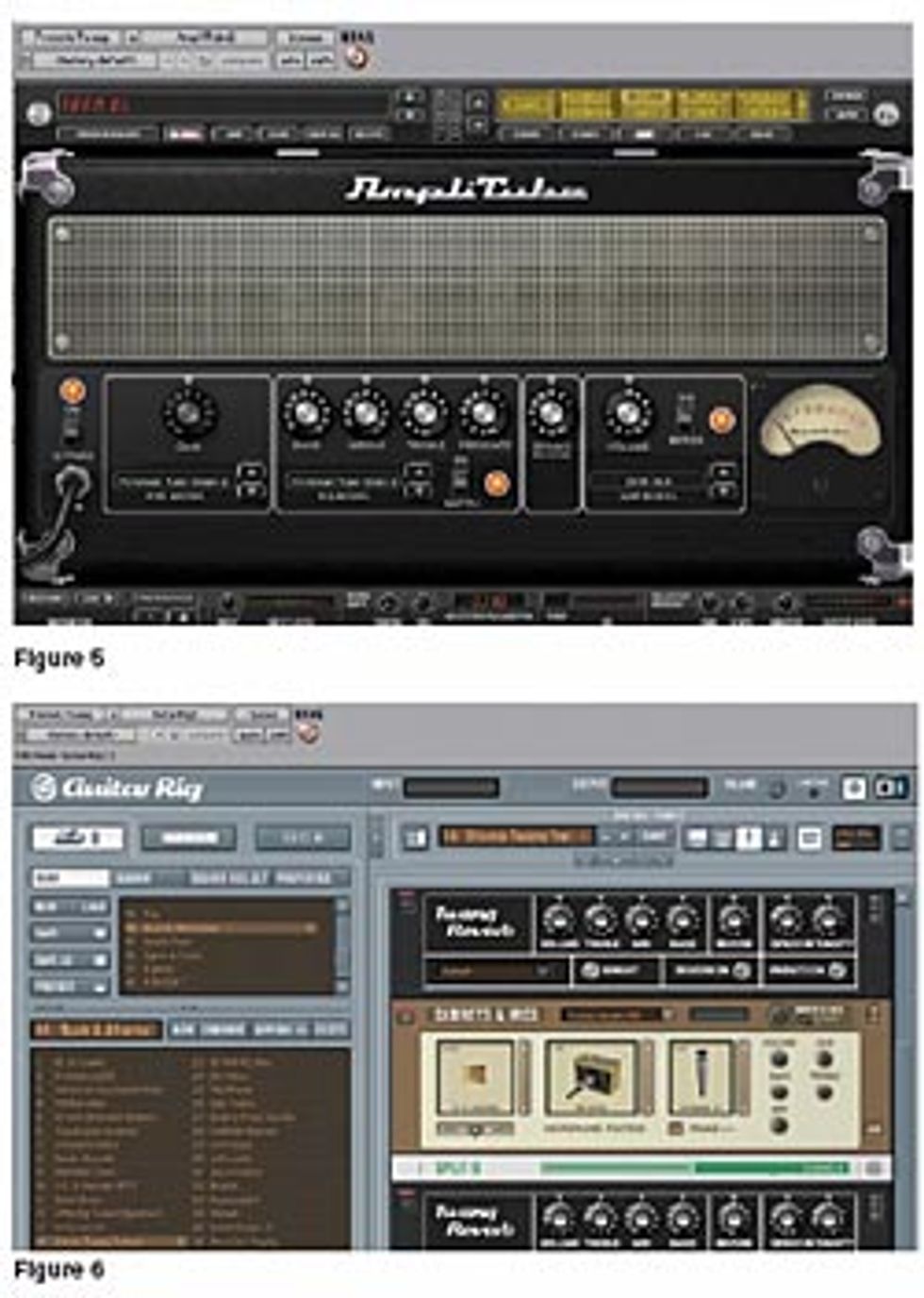 |
How do they sound?
I began by trying to replicate some of the classic meat and potatoes rhythm and lead sounds that have been popular within the last 50 years. Starting with AmpliTube 2, I went looking for a Vox AC30 clean rhythm tone. After auditioning some presets I found one that was built on an AC30 type of amp model that sounded good to me. Others were more distorted or ultra clean. I tweaked the amount of distortion, adding just a little to achieve that “jangly” AC30 sound (fig 3). Most players consider this a “clean” tone, but it usually has some distortion. I was very happy with the result and saved it as “ac30Jangle A2”. Afterwards, I fired up Guitar Rig 2 and went searching for a similar sound. I found a great sounding AC30 (fig 4) and just tweaked various parameters to taste. The resulting clip, called “ac30Jangle G2”, was a little less ballsy– a softer version of a similar sound.
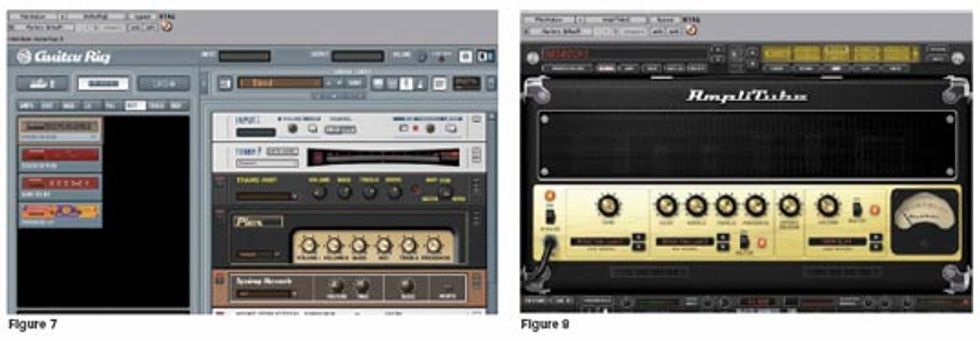
One strategy you could experiment with would be to mix and match tube types within a single amp model. Why not find a sound based on a Fender amp that uses 6L6 power tubes but then change the amp model power tubes to EL84s, as used on an AC30. The resulting sound, impossible to create with real amps, might be exactly the sound you are looking for.
Many guitarists are drawn to classic Fender amp tones, like the renowned 1959 Bassman, the Twin Reverb and others. If you’re talkin’ Fender, you’re talkin’ bright, twangy rhythms with plenty of sparkle and muscular lead tones. I found just what I needed from both applications. There were tons of variations on this classic sound, such as Deluxe Reverb, Fender Twin and the above mentioned Fender Bassman so it was difficult choosing a model. The ’59 Bassman, in particular, is a very popular amp, made famous by Buddy Guy, Stevie Ray Vaughan and countless others. I created clips called “TremTwang A2” and “TremTwang G2” to illustrate the results (figs 5-6) of these classic Fender tones. Both programs also have nice models of the spring reverb found on these classic amps – I was able to go all the way from subtle, to a Dick Daleinspired surf tsunami!
Next on the list of tones to test was the revered Marshall sound. This sound, like most others, is the result of the amplifier and the speaker cabinet working together to arrive at the crunch we’ve known and loved since the ‘60s. Whether it is a plexi stack or a JCM 800, part of the tone recipe has long been a closed back 4x12 speaker cabinet, often with Celestion brand speakers. Since this type of sound is so widely used, there were tons of great presets right out of the box in both applications. I must say that the plethora of presets were well named and gave great indication of the sound of each. Sometimes they hint at the type of amp such as Plex, JCM 800, JCM 900 and sometimes the name reflects the type of effect featured, such as chorus or rotary speaker. I finally found a fat, muscular setting in each program that sounded awesome to my ears – the presets are called “MarshaLaw G2” and “MarshaLaw A2” (figs 7-8). One thing to consider is that when auditioning presets, you will often find something that sounds about right, but when you put it in the context of a song you are recording, it might need some adjustment. It’s very common to have a big guitar rhythm sound that is “too big” when heard in the track with everything else. Both programs give you many ways to sculpt your sound with EQ, compression and effects.

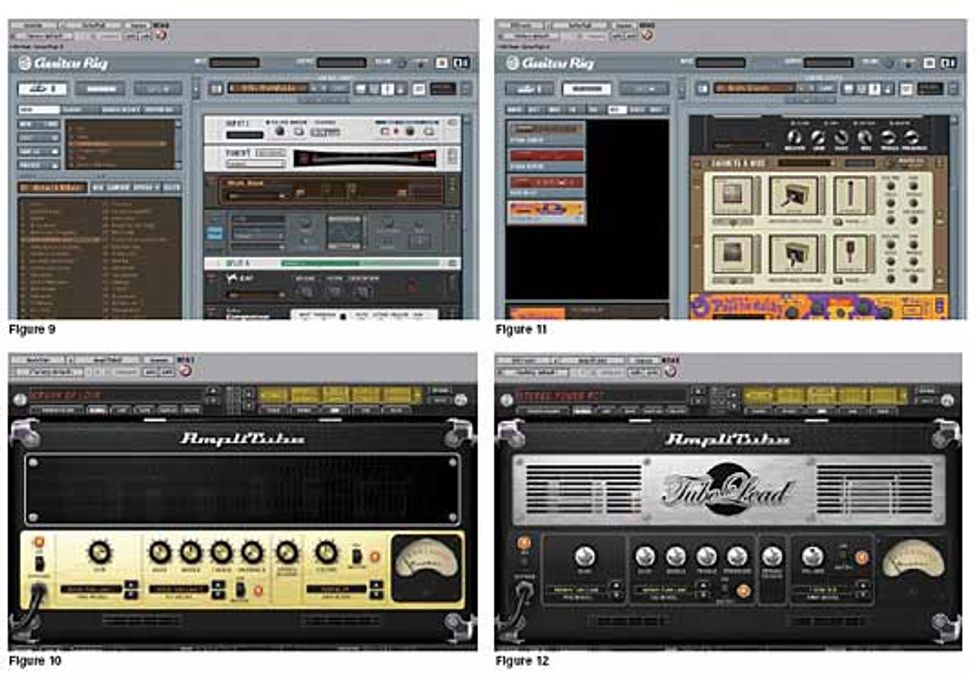
Something worth mentioning is that both programs produced a warm, focused and dynamically responsive sound. I was able to adjust my tone by simply adjusting the volume knob on my guitar – setting it full on for a great lead tone and then cleaning up for chunky rhythm playing by rolling it down. Many tube fanatics look for this dynamic capability in an amp, and it’s a thing of beautiful simplicity to have these applications replicate that – no footpedals to dance on or to get to from across the stage. Both Guitar Rig 2 and AmpliTube 2 have impressive dynamic response, to such a degree that it brought a smile to my face.
In the midst of testing all of these amp and cab variations, I happened upon a preset with an auto wah sound in Guitar Rig 2. It was warm, sustained and would be great for a unique lead solo. Both applications had something similar, but not quite the same. The G2 wah preset followed the rhythm of the way I played each note and the A2 version applied a wah that fluctuated at a predetermined tempo. With that tempo locked to your track, the sound is cool and “in sync.” Both are very useable sounds. Check out AutoWah G2 and A2 (figs 9-10) and decide which you prefer. For the modern rocker, I went in search of a solid-state metal/nu metal amp sound – the type of high gain rhythm sound with a tight, focused bottom-end that works well with drop tunings and often has a “scooped” midrange. The tight bottom and well defined sound is great for strumming of power chords. The resulting SSCrunch clips are different but both are very useable (figs 11-12). Another very popular sound with the metal crowd is the so-called “dual rectifier” sound made popular by amps from Mesa Boogie. These are ultra high-gain sounds with more mids than the above-mentioned solid-state crunch sounds, and are dripping with attitude. Check out the DualRecto clips (figs 13-14) and you’ll see what I mean. Just for fun, I took my DualRecto preset from AmpliTube 2 and produced a variation called “DualRecto Rotary.” It took all of 10 seconds to add the Leslie rotary effect to this preset and the sound was fantastic.
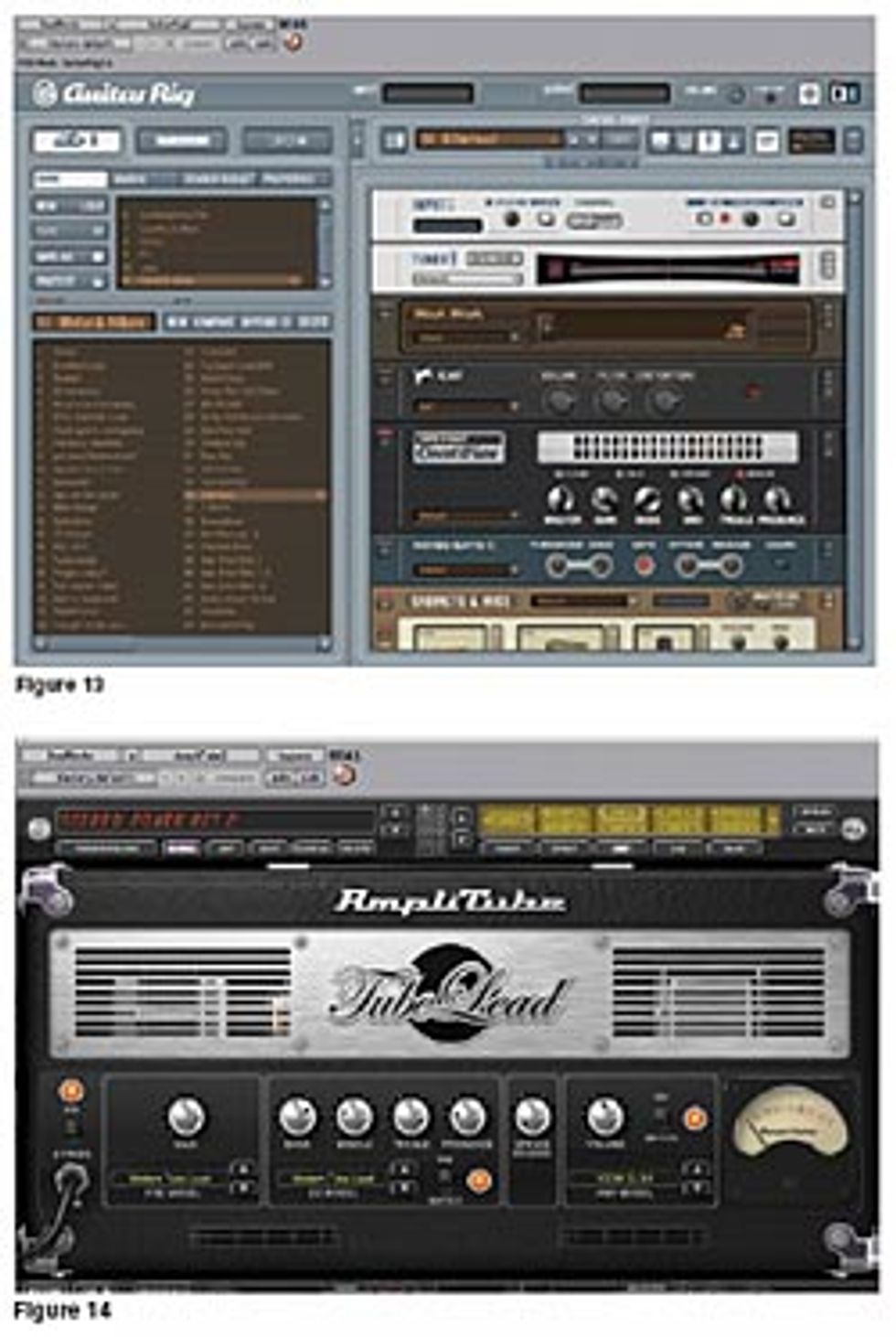 When all is said and done, both programs serve up a huge dose
of great amp and effects tones. How do these applications differ?
I observed that Guitar Rig 2 had a longer list of effects, some classic
and quite unique called Modifiers. The Modifiers can con
trol various parameters in real time, yielding sounds that change
dramatically over time. An example would be a tremolo that starts
fast and then slows down, or delays that create an arpeggio. The
Modifier effect can follow the tempo of the internal metronome
or it can follow the master tempo of a song you are creating in
an application such as Pro Tools. The results can be quite wild.
There are also two included audio file players and a fun-to-use
Looping tool. Simply load a rhythm track into an audio file player
and jam along with it – it sure beats practicing to the lonely click
of a metronome. If you are into experimenting endlessly with
unusual sounds, Guitar Rig 2 may be the way to go. That certainly
does not diminish the amount of classic sounds available and the
included footpedal also makes it very useable in a live setting. It
did make me a bit nervous to have my MacBook Pro onstage if
truth be told, but no one knocked it over and all was fine.
AmpliTube 2 provides what I would describe as very warm and
organic sounds that are extremely convincing and very useable in
the modern studio and on stage with the forthcoming Stomp I/O
footpedal. I was always able to quickly find presets that hit the
nail on the head and it felt just like playing through a real amp.
AmpliTube 2 also includes an audio file player called Speed Trainer,
which makes it a snap to listen to a piece of music you are trying
to learn, slow it down without changing pitch and figure out that
elusive riff. I did find myself yearning for the forthcoming footpedal
so I could use it to rock out live.
When all is said and done, both programs serve up a huge dose
of great amp and effects tones. How do these applications differ?
I observed that Guitar Rig 2 had a longer list of effects, some classic
and quite unique called Modifiers. The Modifiers can con
trol various parameters in real time, yielding sounds that change
dramatically over time. An example would be a tremolo that starts
fast and then slows down, or delays that create an arpeggio. The
Modifier effect can follow the tempo of the internal metronome
or it can follow the master tempo of a song you are creating in
an application such as Pro Tools. The results can be quite wild.
There are also two included audio file players and a fun-to-use
Looping tool. Simply load a rhythm track into an audio file player
and jam along with it – it sure beats practicing to the lonely click
of a metronome. If you are into experimenting endlessly with
unusual sounds, Guitar Rig 2 may be the way to go. That certainly
does not diminish the amount of classic sounds available and the
included footpedal also makes it very useable in a live setting. It
did make me a bit nervous to have my MacBook Pro onstage if
truth be told, but no one knocked it over and all was fine.
AmpliTube 2 provides what I would describe as very warm and
organic sounds that are extremely convincing and very useable in
the modern studio and on stage with the forthcoming Stomp I/O
footpedal. I was always able to quickly find presets that hit the
nail on the head and it felt just like playing through a real amp.
AmpliTube 2 also includes an audio file player called Speed Trainer,
which makes it a snap to listen to a piece of music you are trying
to learn, slow it down without changing pitch and figure out that
elusive riff. I did find myself yearning for the forthcoming footpedal
so I could use it to rock out live.
Both programs are an absolute blast, and are truly incredible in their depth and realism. I’ve only been able to scratch the surface here, as there are far too many sounds to describe with both AmpliTube 2 and Guitar Rig 2. With the arrival of such incredible modeling software, today’s guitarist has powerful tone tools at his/her fingertips. Even the most stubborn tube amp fanatics should give these applications a listen. The sounds are inspiring and versatile! Why not fire up your PC or Mac with either and get rockin; for many of us, it’s the only way we will ever have access to hundreds of great classic and modern amp and effects combinations.
| MODELING, iLife Style? |
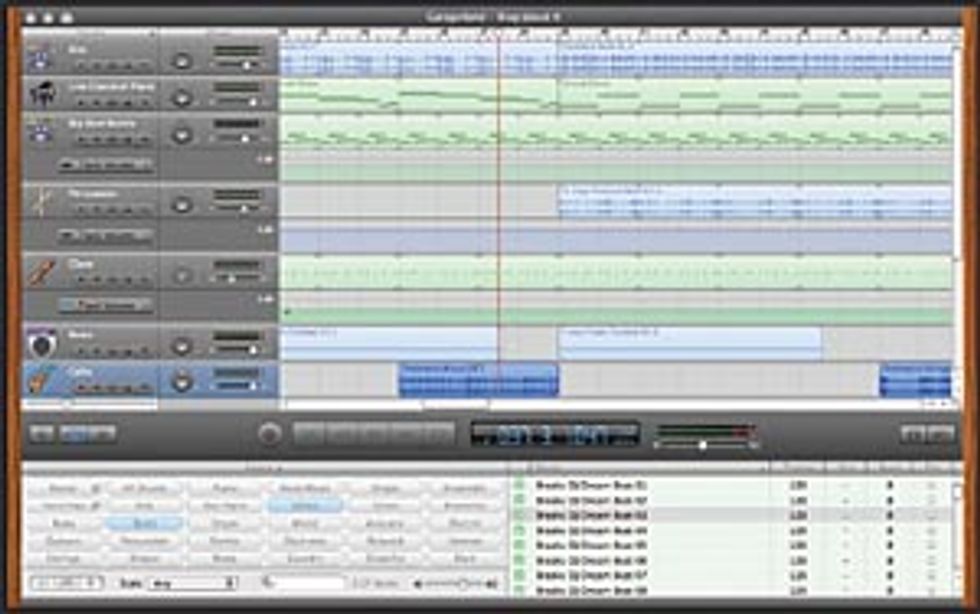 Readers with recent Apple computers (2004 and
later) have likely experienced the included free
application called GarageBand, a full-blown recording
studio environment. Included in the Apple iLife
suite, this stand alone application features quite
a few amp and effect simulations, ranging from
twangy Fender amps to high gain lead guitar tones.
You can even add effects like reverb, delay, distortion,
EQ, chorus, flanger and more to your sound
and save it for future use. I’ve personally used these
sounds to create a CD called The Garage Album
(thegaragealbum.com) and several of the sounds
are quite useable. With a little tweaking to allow for
different types of guitars and playing styles, these
sounds are fun and convenient. You also get keyboard
sounds, loops in many styles, and effects presets
that can be applied to vocal, guitar, bass and
synth sounds. Make no mistake, the amp/fx models
in dedicated programs such as Guitar Rig 2 and
Amplitube 2 are much more in-depth and useable
than those found in GarageBand, but if you’re on a
Mac and looking for a quick change of pace, you
might consider this.
Readers with recent Apple computers (2004 and
later) have likely experienced the included free
application called GarageBand, a full-blown recording
studio environment. Included in the Apple iLife
suite, this stand alone application features quite
a few amp and effect simulations, ranging from
twangy Fender amps to high gain lead guitar tones.
You can even add effects like reverb, delay, distortion,
EQ, chorus, flanger and more to your sound
and save it for future use. I’ve personally used these
sounds to create a CD called The Garage Album
(thegaragealbum.com) and several of the sounds
are quite useable. With a little tweaking to allow for
different types of guitars and playing styles, these
sounds are fun and convenient. You also get keyboard
sounds, loops in many styles, and effects presets
that can be applied to vocal, guitar, bass and
synth sounds. Make no mistake, the amp/fx models
in dedicated programs such as Guitar Rig 2 and
Amplitube 2 are much more in-depth and useable
than those found in GarageBand, but if you’re on a
Mac and looking for a quick change of pace, you
might consider this.
|
